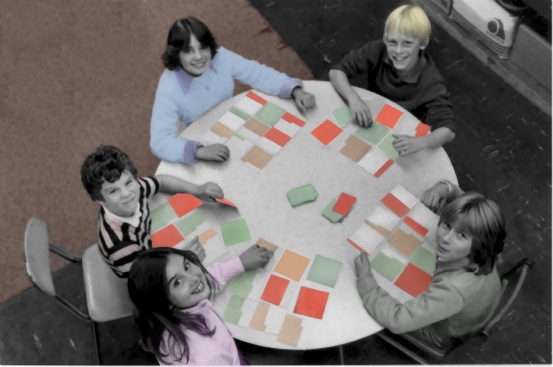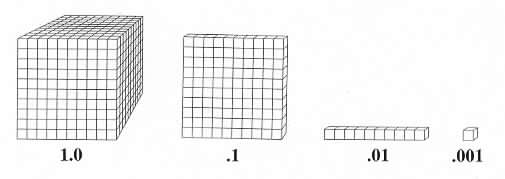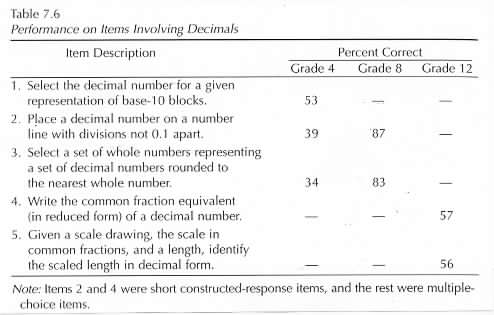|
|
|
|
|
|
|
|
|
|
|
|
|
|
|
|
|
|
|
|
|
|
|
|
|
|
|
Philosophy and Purpose
|
|
|
|
|
|
|
|
. |
|
|
|
|
|
|
|
|
|
The main purposes of the Decimal Squares program are to provide students with conceptual understanding of decimal notation and operations and to help them become competent in using decimals and performing operations.
|
|
|
|
|
|
The philosophy of the Decimal Squares program is based on the belief that students need non-threatening experiences with concrete models for decimals before the introduction of decimal notation and rules
and that learning should precede through the following levels: readiness - pictorial - abstract. The use of models at the readiness level and through to the abstract level reduces anxiety and provides understanding for decimals and their operations.
|
|
Each student has formed a 3 x 3 array of Decimal Squares. As a decimal playing card is turned up
any student who has the square for the decimal can turn over the square. This game connects the model to decimal symbols. |
|
|
|
|
 |
|
|
|
|
|
|
|
|
|
|
Photo courtesy of Herb Moyer |
|
|
|
Unlike the lengthy readiness period for whole numbers and their operations
decimal notation and their operations are often taught with little attention to models for understanding decimal concepts. This practice is partially successful because the operations with decimals are so similar to the operations with whole numbers. However
research shows that at all levels
including the college undergraduate level
decimal concepts and notation are often misunderstood.
. |
|
|
|
|
|
Origin of Decimal Squares |
|
|
|
|
In the early 1980s
I received a phone call from a fourth grade teacher who inquired about models for teaching decimals. When I suggested using base ten blocks
she said her students had used this model for whole numbers but were having difficulty using it for decimals. She commented: "There must be another model for teaching decimals." This discussion led to the development of Decimal Squares
a part-to-whole model for teaching decimal symbolism and operations.
When using base ten blocks for teaching whole numbers
the unit is the smallest block or cube
and the largest is the 10 x 10 x 10 block. When teaching decimals
the 10 x 10 x 10 block (or sometimes the 10 x 10 block) is taken as the unit and successively smaller blocks represent .1
and .001.
|
|
|
|
|
|
|
|
|
|
|
|
|
|
|
|
|
|
 |
|
|
|
|
|
|
|
|
|
|
|
|
|
|
|
|
While the base ten blocks can be used to illustrate the important concept that the decimal for a quantity depends on the unit
it appears that this model may cause confusion for some students when it is first used to model whole numbers and later used to model decimals. Another problem may be that the base ten blocks are not a part-to-whole model. With a part-to-whole model
whether it be for fractions
decimals
or percents
students can see the whole and the sub-region representing the part. The part-to-whole model for teaching decimals and fractions is especially appropriate for students because it has so many applications to which they can relate.
Research results shown below from the Seventh Assessment of the National Assessment of Educational Progress (c. 2000)
discuss the confusion that may be due to using base ten blocks:
In item 1
fourth-grade students were asked to select the number associated with a base-10 block representation in which the 1 and the 0.01 blocks were identified. Approximately one-half of the fourth-grade students chose the correct response. About one-third of the students responded either by selecting the option with all of the digits to the right or to the left of the decimal point
suggesting that they were probably using whole-number ideas to choose the number.
. |
|
|
|
|
|
 |
|
|
